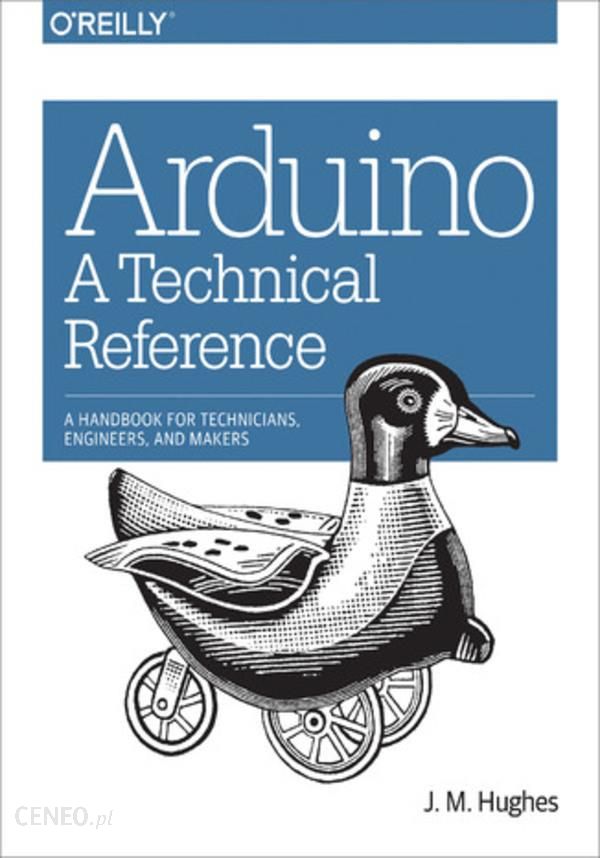Description
Arduino: A Technical Reference – J. M. Hughes
Rather than yet another project-based workbook, Arduino: A Technical Reference is a reference and handbook that thoroughly describes the electrical and performance aspects of an Arduino board and its software.This book brings together in one place all the information you need to get something done with Arduino. It will save you from endless web searches and digging through translations of datasheets or notes in project-based texts to find the information that corresponds to your own particular setup and question.Reference features include pinout diagrams, a discussion of the AVR microcontrollers used with Arduino boards, a look under the hood at the firmware and run-time libraries that make the Arduino unique, and extensive coverage of the various shields and add-on sensors that can be used with an Arduino. One chapter is devoted to creating a new shield from scratch.The book wraps up with detailed descriptions of three different projects: a programmable signal generator, a „smart” thermostat, and a programmable launch sequencer for model rockets. Each project highlights one or more topics that can be applied to other applications. Spis treści:PrefaceIntended AudienceWhat This Book IsWhat This Book Is NotAbout TerminologyWhats in This BookEndorsementsConventions Used in This BookSafari Books OnlineHow to Contact UsAcknowledgments1. The Arduino FamilyA Brief HistoryTypes of Arduino DevicesArduino GalleriesArduino-Compatible DevicesHardware-Compatible DevicesSoftware-Compatible DevicesThe Arduino Naming ConventionWhat Can You Do with an Arduino?For More Information2. The AVR MicrocontrollerBackgroundInternal ArchitectureInternal MemoryPeripheral FunctionsControl RegistersDigital I/O Ports8-Bit Timer/Counters16-Bit Timer/CountersTimer/Counter PrescalerAnalog ComparatorAnalog-to-Digital ConverterSerial I/OUSARTSPITWIInterruptsWatchdog TimerElectrical CharacteristicsFor More Information3. Arduino-Specific AVR MicrocontrollersATmega168/328MemoryFeaturesPackagesPortsPin FunctionsAnalog Comparator InputsAnalog InputsSerial InterfacesTimer/Clock I/OExternal InterruptsArduino Pin AssignmentsBasic Electrical CharacteristicsATmega1280/ATmega2560MemoryFeaturesPackagesPortsPin FunctionsAnalog Comparator InputsAnalog InputsSerial InterfacesTimer/Clock I/OExternal InterruptsArduino Pin AssignmentsElectrical CharacteristicsATmega32U4MemoryFeaturesPackagesPortsPin FunctionsAnalog Comparator InputsAnalog InputsSerial InterfacesTimer/Clock I/OExternal InterruptsUSB 2.0 InterfaceElectrical CharacteristicsArduino Pin AssignmentsFuse BitsFor More Information4. Arduino Technical DetailsArduino Features and CapabilitiesArduino USB InterfacesArduino Physical DimensionsFull-Size Baseline Arduino PCB TypesMega Form-Factor Arduino PCB TypesMega and Mega2560Mega ADKSmall Form-Factor Arduino PCB TypesMiniPro MiniNanoFioMicroSpecial-Purpose PCB TypesLilyPadEsploraArduino Pinout ConfigurationsThe Baseline Arduino Pin LayoutThe Extended Baseline Pin LayoutUno R3EthernetLeonardoThe Mega Pin LayoutNonstandard LayoutsLilyPadNanoMiniPro MiniFioEsploraMicroFor More Information5. Programming the Arduino and AVR MicrocontrollersCross-Compiling for MicrocontrollersBootloadersThe Arduino IDE EnvironmentInstalling the Arduino IDEWindowsLinuxMac OS XConfiguring the Arduino IDECross-Compiling with the Arduino IDEThe Arduino Executable ImageThe Arduino Software Build ProcessSketch TabsArduino Software ArchitectureRuntime Support: The main() FunctionAn Example SketchConstantsGlobal VariablesLibrariesUsing Libraries in SketchesAdding a Library to the Arduino IDECreating Custom LibrariesArduino Source Code6. Life Without the Arduino IDEIDE AlternativesPlatformIOInoThe AVR ToolchainInstalling the ToolchainWindows installationLinux installationMac OS X installationmakeavr-gccbinutilsavr-libcBuilding C or C++ Programs from ScratchCompiling with avr-gcc or avr-g++Multiple Source Files and makeAVR Assembly LanguageThe AVR Programming ModelCreating AVR Assembly Language ProgramsAVR Assembly Language ResourcesUploading AVR Executable CodeIn-System ProgrammingProgramming with the BootloaderUploading Without the BootloaderJTAGAVRDUDEUsing an Arduino as an ISPBootloader OperationReplacing the BootloaderSummary7. Arduino LibrariesLibrary ComponentsContributed Libraries8. ShieldsElectrical Characteristics of ShieldsPhysical Characteristics of ShieldsStacking ShieldsCommon Arduino ShieldsInput/OutputI/O Extension ShieldsI/O Expansion ShieldsRelay ShieldsSignal Routing ShieldsMemoryCommunicationSerial I/O and MIDIEthernetBluetoothUSBZigBeeCANPrototypingCreating a Custom Prototype ShieldMotion ControlDC and Stepper Motor ControlPWM and Servo ControlDisplaysLED arrays7-segment LED displaysLCD displaysTFT displaysInstrumentation ShieldsAdapter ShieldsMiscellaneous ShieldsUncommon Arduino ShieldsSources9. Modules and I/O ComponentsModulesPhysical Form FactorsInterfacesModule SourcesModule DescriptionsKEYES modulesSainSmart modulesTinkerKit modulesGrove ModulesSensor and Module DescriptionsSensorsTemperature, Humidity, and Pressure SensorsDS18B20DHT11 and DHT22 sensorsThermistorsWater sensorsSoil moisture sensorsBarometric sensorsTilt SensorsSingle-axis tilt sensorsDual-axis tilt sensorsAudio SensorsLight SensorsPhotocellsPhotodiodesPhototransistorsPIR sensorsMagnetic SensorsHall effect sensorsMagnetometer sensorsVibration and Shock SensorsMotion SensorsGyroscopesAccelerometersContact and Position SensorsContact switchesDigital rotary encodersLaser transmitter/receiversRange SensorsLED object sensorsUltrasonic range findersCommunicationsAPC220 Wireless Modules315/433 MHz RF ModulesESP8266 TransceiverNRF24L01RS-232 adapterOutput Devices and ComponentsLight SourcesSingle-color LEDsBicolor LEDsTricolor (RGB) LEDsLED matrix7-segment LED display7-segment LED modulesLasersRelays, Motors, and ServosRelaysServo controlDC motor controlStepper motor controlAnalog Signal OutputsBuzzersDAC modulesWaveform generatorsUser InputKeypadsJoysticksPotentiometers and Rotary EncodersUser OutputText DisplaysERM1601SBS-2ST7066 (HD44780)Graphical DisplaysERC240128SBS-1ST7735RSupport FunctionsClocksDS1302 RTC moduleDS1307 RTC moduleDS3231 RTC moduleRTC module using PCF8563TimersConnectionsWorking with Naked Jumper WiresModule Connection SystemsBuilding Custom ConnectorsChoosing a Connection MethodSourcesSummary10. Creating Custom ComponentsGetting StartedCustom ShieldsPhysical ConsiderationsStacking ShieldsElectrical ConsiderationsThe GreenShield Custom ShieldObjectivesDefinition and PlanningDesignFunctionalityHardwareSoftwarePrototypePrototype softwarePrototype testingFinal SoftwareSource code organizationSoftware descriptionFabricationFinal Acceptance TestingOperationNext StepsCustom Arduino-Compatible DesignsProgramming a Custom DesignThe SwitchinatorDefinition and PlanningDesignFunctionalityHardwareSoftwarePrototypePrototype softwarePrototype testingSoftwareSource code organizationSoftware descriptionFabricationAcceptance TestingNext StepsResources11. Project: A Programmable Signal GeneratorProject ObjectivesDefinition and PlanningDesignFunctionalityEnclosureSchematicPrototypeControl Inputs and ModesDisplay OutputDDS ModuleSoftwareSource Code OrganizationSoftware DescriptionThe DDS LibraryTestingFinal AssemblyPull-up Resistor ArrayInput ProtectionChassis ComponentsDC PowerFinal Testing and ClosingReducing the CostCost BreakdownResources12. Project: Smart ThermostatBackgroundHVAC OverviewTemperature Control BasicsSmart Temperature ControlProject ObjectivesDefinition and PlanningDesignFunctionalityEnclosureSchematicSoftwareUser Input/OutputControl OutputPrototypeDHT22 SensorRotary EncoderReal-Time Clock ModuleLCD ShieldSoftwareSource Code OrganizationSoftware DescriptionTestingFinal VersionAssemblyTesting and OperationCost BreakdownNext StepsResources13. Model Rocket Launcher: A Design StudyOverviewThe Design CycleObjectivesSelecting and Defining Functional RequirementsCreating the Preliminary DesignDesign FeasibilityPreliminary Parts ListPrototypeFinal DesignElectricalPhysicalSoftwareTesting and OperationCost AnalysisA. Tools and AccessoriesHand ToolsScrewdriversPliers and CuttersWire StrippersConnector Crimping ToolsSawsPower ToolsDrillsMiniature GrinderMiniature Drill PressSolderingSoldering IronsSoldering AccessoriesTool SourcesB. AVR ATmega Control RegistersATmega168/328ATmega1280/2560ATmega32U4C. Arduino and Compatible Products VendorsArduino ProductsHardware-Compatible Boards and ShieldsSoftware-Compatible BoardsSensors, Add-on Boards, and ModulesElectronics SoftwareOpen Source Schematic Capture ToolsCAE Software ToolsPCB Layout ToolsHardware, Components, and ToolsElectronic Component ManufacturersElectronics Distributors (USA)Discount and Surplus ElectronicsMechanical Parts and Hardware (Screws, Nuts, Bolts)Electronic Enclosures and ChassisToolsTest EquipmentPrinted Circuit Board Supplies and FabricatorsPrototype and Fast-Turnaround FabricatorsPCB Kit SourcesOther SourcesD. Recommended ReadingArduinoAVRC and C++ ProgrammingGeneral ElectronicsInterfacesInstrumentationPrinted Circuit BoardsE. Arduino and AVR Software Development ToolsCompilers/AssemblersIntegrated Development Environments (IDEs)Programming ToolsSimulatorsIndex
E-Beletrystyka
how to, zestaw policyjny dla dzieci, bombka styropianowa, jak zmyć klej z plastiku, a2 kartka, kalendarz swieta 2019, butelka whisky, czym usunąć klej z szyby po folii, wkład brita maxtra, rura pole dance, aglaonema crete, kartki a4, babeczki gotowe
yyyyy




